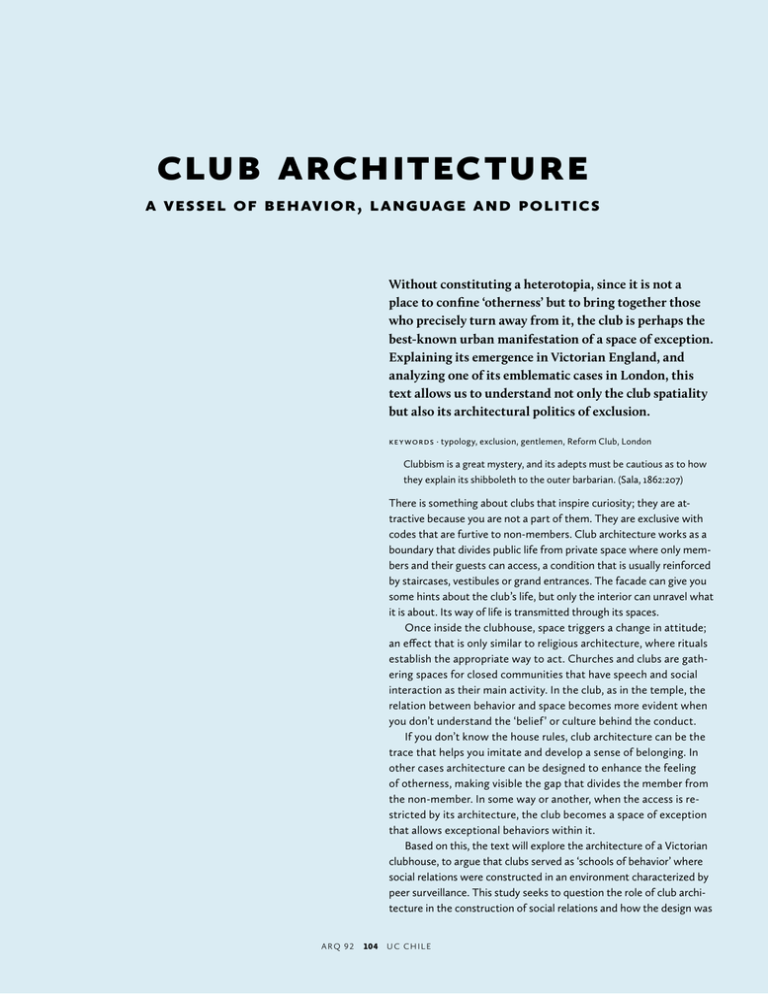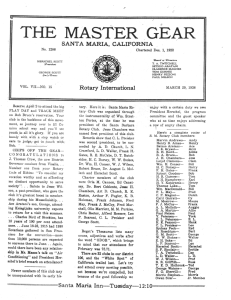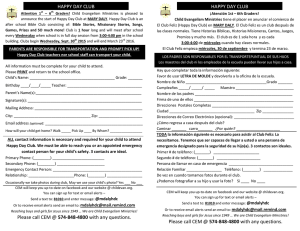Club ArChiteCture
Anuncio

Club Architecture a vessel of behavior, language and politics Without constituting a heterotopia, since it is not a place to confine ‘otherness’ but to bring together those who precisely turn away from it, the club is perhaps the best-known urban manifestation of a space of exception. Explaining its emergence in Victorian England, and analyzing one of its emblematic cases in London, this text allows us to understand not only the club spatiality but also its architectural politics of exclusion. Keywords · typology, exclusion, gentlemen, Reform Club, London Clubbism is a great mystery, and its adepts must be cautious as to how they explain its shibboleth to the outer barbarian. (Sala, 1862:207) There is something about clubs that inspire curiosity; they are attractive because you are not a part of them. They are exclusive with codes that are furtive to non-members. Club architecture works as a boundary that divides public life from private space where only members and their guests can access, a condition that is usually reinforced by staircases, vestibules or grand entrances. The facade can give you some hints about the club’s life, but only the interior can unravel what it is about. Its way of life is transmitted through its spaces. Once inside the clubhouse, space triggers a change in attitude; an effect that is only similar to religious architecture, where rituals establish the appropriate way to act. Churches and clubs are gathering spaces for closed communities that have speech and social interaction as their main activity. In the club, as in the temple, the relation between behavior and space becomes more evident when you don’t understand the ‘belief ’ or culture behind the conduct. If you don’t know the house rules, club architecture can be the trace that helps you imitate and develop a sense of belonging. In other cases architecture can be designed to enhance the feeling of otherness, making visible the gap that divides the member from the non-member. In some way or another, when the access is restricted by its architecture, the club becomes a space of exception that allows exceptional behaviors within it. Based on this, the text will explore the architecture of a Victorian clubhouse, to argue that clubs served as ‘schools of behavior’ where social relations were constructed in an environment characterized by peer surveillance. This study seeks to question the role of club architecture in the construction of social relations and how the design was A R Q 9 2 104 U C C H I L E Sol Pérez Martínez PhD (c) in Architecture and Education University College London, London, England used to teach conduct cues that bonded particular sections of society, while therefore, barring others. In order to do this the text will firstly present the origins of club culture in England, to delve then into one of its most celebrated and well-preserved examples. By studying one club and its relation to the society it served, this text seeks to expose the social relations made available by built space and the political agency behind who designed them. the club’s origins: from coffee houses to civic buildings Clubs are a form of social organization that was created in England and later embodied in an architectural type in London during the 18th century. Nobody knows with certainty how, but the word ‘club’ started to form part of the English vocabulary during the 17th century and, since then, has been intensely disseminated unaltered across languages. The earliest known written expression of ‘club’ was in 1659, by John Aubrey, referring to the constant meeting of a specific type of people –not bound by blood– that gathered in a particular place (Timbs, 1866). Even though there is no agreement about its origins, most authors concur that the word ‘club’ and the institution of the club are firmly rooted in British history, weather and behaviour (Fagan, 1887). Clubs flourished during the late 17th century in London using taverns and the back rooms of coffeehouses as their transitory headquarters.1 And although in their beginnings they used existing spaces to gather men of a varied social background (separating them from the rest of society to share their common interests, drink, read and socialize), when the scope of memberships began to increase, clubs would take over the whole space of the coffeehouse as their meeting place. Run by hospitality entrepreneurs, clubs «began as private spaces within public venues” (Rendell, 2002:68) evolving later into completely self-contained sites managed by an elected members committee, where club talk was open and protected by the mutual trust between members. Consequently, the space of the club had to adapt to the changes of the membership that it served, from democratic to exclusive (Milne-Smith, 2011) and creating the need for a new typology of architecture that colonized London’s West End (fig. 1 ). In Victorian society the private clubhouse was a key space in the city to access knowledge and influence, making it possible to have casual social interactions with people who were related to culture and power. At a time when it was a complex social dance to 1 Anyone who paid a small fee could access a Coffeehouse or a Tavern, becoming the epitome of the democratic public sphere in London in the early 1700s. Rendell explains that Coffeehouses were spaces for radical politics, free speech and debate in a distended environment while Taverns were controlled settings with an air of respect that didn’t allow a fluid debate (Rendell, 2002). E XC E P C I O N E S 105 E XC E P T I O N S FI G 1 Thevoz, Septiembre / September 2013. Mapa de clubes de damas y caballeros en West End, Londres / A map of Ladies and Gentlemen’s clubs of the West End of London. c. 1900. Fuente / Source: http://www.historytoday.com/seth-alexanderthévoz/london-clubs-and-victorian-politics establish new acquaintances because of an intricate etiquette system, clubs had the relevant role of housing a premade ‘social set’ (Taddei, 1999). By becoming a member of a club a gentleman chose a particular society and agreed to adopt a way of behaving in relation to his peers. Therefore, clubs served as formative institutions that, by accepting their rules and paying a fee, granted access to comfortable spaces where members could participate in new social networks. But money, status or contacts weren’t enough to become part of a club if you weren’t considered a gentleman. gentlemen, honour and etiquette The club is the setting where the gentleman acts, making both definitions evolve together. Since its origin, the term ‘gentleman’ has been indicative of noble English men of good conduct, a category only accessible to the aristocracy by birth and the correct upbringing. However with the industrial revolution and the appearance of the middle classes during the Victorian Era, the term ‘gentleman’ would challenge the class system and was related to behavior, controlled by peer surveillance through a code of honor which consisted of a strict set of manners and etiquette; this code had to be followed in order to be respectable and to deal with strangers in a fast growing city, shaming those who didn’t meet the standards and praising those who excelled (McKay, 2012). Taddei clarifies that during the 19th century the word ‘gentleman’ defined “an ideal of conduct as well as a social rank” (Taddei, 1999:16), a social status that could be achieved with education and the correct behavior, symbolizing the first possibility of social fluidity in the British upper classes (McKay, 2012). The club became a ‘school of behavior’, helping to formulate and establish the manners and etiquette that a gentleman should adopt in order to access the world of aristocracy.2 ‘Clubmen’ became a synonym for ‘gentlemen’, a title for truthful and courteous men, with “a clear soul, and a fearless, straightforward tongue” (Vernon, 1869:241). As explained by Milne-Smith, clubs were “key sites of male gossip” (Milne-Smith, 2009:88), where talking was 2 “Compared with the previous system of living, clubs induce habits of economy, temperance, refinement, regularity, and good order… there cannot be better security for the good behaviour of a husband than that he should have been trained in one of these institutions” (Watford 1878:140). A R Q 9 2 106 U C C H I L E FI G 2 Athenaeum Club, Londres, 2014 © Sol Pérez Martínez FI G 3 The Reform Club, Londres, 2014 © Sol Pérez Martínez the main attraction and activity. Part of the gentlemanly ideal was to show the wit and knowledge of the speaker. Knowing the spaces, the manners and the appropriate topics was a way of indicating power and belonging to the group. Each club represented a type of gentleman and had its own silent language. As a result, gentleman status during the Victorian era wasn’t a homogeneous category; consequently, neither was its architecture. the gentlemen’s club t ypology One may be virtuous or polished, as a pebble is rough or polished, by the rubbing of what surrounds us. (Ledoux, 1802:3) Analyzing the typology of Victorian Clubs, there are three distinctive moments associated with the evolving figure of ‘the gentleman’. The first was the townhouse typology used by coffeehouses, and afterwards by the initial private clubs, that represented the idea of the ‘home away from home’: three or four floors and an asymmetric layout with a lateral entrance door.3 The club was a place for aristocratic gentlemen to mingle and solve their social affairs, like for example an extension of the living rooms in their country houses. The only element that distinguished the club from other townhouses was its bow window, where clubmen would display themselves while they surveyed the street. This new typology represented a crossing between the safe domestic space and the male brotherhood of the public coffeehouse. The second generation of clubs reflected variations in the English society class system at the beginning of the 19th century. The scope of the memberships changed from being exclusive to upper class gentlemen, to including gentlemen from a growing middle class. Newly formed clubs wanted to establish their status in the streetscape with a temple or palace typology adopting the expressions of Greek classic architecture. For these new clubhouses the architecture style was the way of representing their value and club culture to other citizens. As explained by Crook the main difference with the 18th century clubs was their architectural role in the 19th century urban design of London (Crook, 1981) (fig. 2). According to Fagan, in a single decade from 1832 to 1842, the greatest clubs were built in Pall Mall, creating “an almost 3 The first clubs included Arthur’s or White’s (1697), Brook’s (1764) and Boodle’s (1762). E XC E P C I O N E S 107 E XC E P T I O N S FI G 4 The Reform Club, Londres. Fuente / Source: http://inretrospectmagazine. com/article/the-act-ofreform/ 0 1 2 3 4 5 6 7 8 9 10 11 12 FI G 5 Diagrama de Vidler para The Reform Club / Vidler’s Diagram for The Reform Club. Dibujo / Drawing: Sol Pérez Martínez Le yenda / Legend: 0. Calle / Street; 1. Acceso escalera puente / Bridge stair entrance; 2. Vestíbulo controlado por portería / Vestibule controlled by porter; 3. Escalera cerrada / Enclosed staircase; 4. Percepción de contraste / Perception contrast; 5. Hall o Salón / Hall or Saloon; 6. Percepción de contraste / Perception contrast; 7. Escalera cerrada / Enclosed main staircase; 8. Percepción de contraste / Perception contrast; 9. Galerías / Galleries; 10. Percepción de contraste / Perception contrast; 11. Biblioteca / Library; 12. Chimenea / Fireplace A R Q 9 2 108 U C C H I L E FI G 6 Planos esquemáticos del Club de la Reforma / Schematic plans of The Reform Club. Dibujos / Drawings: Sol Pérez Martínez Planta nivel acceso Ground floor plan 5 6 E. / S. 1: 750 2 the reform club: political headquarters, gossip and the victorian gentleman 3 4 1 0 0 10 Planta primer nivel First floor plan 11 E. / S. 1: 750 12 6 10 7 8 9 Le yenda / Legend: 0. Calle Pall Mall / Pall Mall Street; 1. Vestíbulo / Vestibule ; 2. Hall o Salón / Hall or Saloon; 3. Sala de mañana / Morning Room; 4. Habitación de extraños / Strangers Room; 5. Coffee Room; 6. Escalera cerrada / Enclosed staircase; 7. Galería primer nivel / Gallery First Floor; 8. Sala de juegos / Card Room; 9. Sala de comité / Committee Room; 10. Sala de fumadores / Smoking Room; 11. Biblioteca / Library; 12. Billar / Billiard Corte este-oeste / Section from east to west S. E. / N. S. uninterrupted line of temples dedicated to social intercourse and the interchange of ideas” (Fagan 1887:12).4 During this time, the third generation of clubs can be recognized by a shift in club architecture: from a Classic representation to Italian Renaissance; a style that was best achieved in Barry’s Reform Club (Sheppard, 1960), a unique building with a strong civic imprint that, along with adopting a Renaissance aesthetic and a more public layout, it also included as its main activity the most civic of occupations: politics (fig. 3 ). The Reform Club was a political and social club created after the Reform Bill of 1832 to congregate all the liberal parties under one roof with the aim of promoting “the social intercourse of the Reformers of the United Kingdom” (Fagan 1887:13). The Reform symbolizes a period where politics was, after socializing, one of the most common aims of clubs (Taddei, 1999). However, while social clubs tried to leave politics aside to protect the calm atmosphere of club life, political clubs hosted rallies and connected to specific political events seeking to “link between the leaders and the led, to maximize the vote, and to co-ordinate this process between constituencies” (Sharpe, 1996). A year after the Reform Club was founded its committee “was instructed to request seven architects of talent and experience to make plans and estimates for a new Club House” (Sheppard, 1960:408). In 1837 Sir Charles Barry was unanimously selected, an architect with Whig affiliations who had recently built the Traveller’s Club next door. The club was established at Nº 104 Pall Mall only separated by a narrow street from the Carlton Club, the conservative conclave. Their political opposition was not only exposed in parliament but also manifested in the city, where their headquarters would face each other’s windows. As with every Gentlemen’s Club, the Reform is difficult for an outsider to describe; the information is restricted and there are scarce images available of their interiors. Part of its exclusivity is based on maintaining these kinds of restrictions. Even though the texts available are accurate and detailed in describing its architecture, it is hard to grasp the atmosphere of the Reform and the relation between the space and its users. Contrasting to these depictions, visiting the Club makes you see a lived space where architecture gives clues into the social history related to the building, enhanced by the fact that it has been completely restored and its furniture has been maintained (fig. 4 ). Following Frankl in architecture there is a narrative of interactions implied that “provides the path for a definite sequence of events” and therefore “forms the fixed arena for actions of specific duration” (Forty 2001:106). In the club, members have a routine guided by the house rules and etiquette, where certain behaviors are associated to specific architectural settings. Each of the ‘situational frames’ represented in the diagram houses a different kind of social interaction that can be explained using spatial cues (fig. 5 ). 4 Fagan referred to the Athenaeum (1830), the Travellers (1832), The Carlton (1835) and the Reform (1837) All neighbouring buildings in Pall Mall. E XC E P C I O N E S 109 E XC E P T I O N S FI G 7 Walter Wilson. Reform Club: The Hall. 1890. Fuente / Source: The Illustrated London News. p.682. Courtesy of Adrian Forty. FI G 8 Walter Wilson. Reform Club: The Galleries Afternoon Tea. 1890. Fuente / Source: The Illustrated London News. p.683. Courtesy of Adrian Forty. FI G 9 Walter Wilson. Reform Club: The Library. Drawing Tea. 1890. Fuente / Source: The Illustrated London News. p.684. Courtesy of Adrian Forty. To access the Reform Club a set of stairs forms a bridge that separates the building from the street, creating a middle ground for the vestibule controlled by the porter after crossing a double door. This strategy leaves the guest in a limbo space, waiting to be accepted into the club. The design reinforces the ambiguity of inside and outside, with walls that mimic the exterior of the building (Sheppard, 1960). Next, another set of stairs separates the vestibule from the piano nobile of the ground floor. Through a secluded, dimly lit space there is an access into the vast double-height hall lit by a glass dome. The contrast of colours, light and space creates an impressive effect that makes the visitor stop to adjust their vision and behaviour (fig. 6 ).5 The Hall, a covered Italian courtyard, is the characteristic space of the Reform with a gallery that surrounds both floors and distributes access to all the members’ rooms. As the most connected space of the plan, with no specific function, it is a central void that allows casual meetings (fig. 7). In one of the walls of the saloon there is the access to the enclosed main staircase of the Reform Club. Compared to the large void of the hall, the staircase seems confined. It is a subtraction carved into the wall, a connector tube that is not evident to the guest, making the first floor even more private than the ground floor. Its design enhances the idea of the staircase as a room using fixed furniture on its landing: a habitable space away from the eyes of the other members but at the same time where an encounter is difficult to avoid. The mirrors on the walls make it a space of deceit; veiled but public, the staircase is the perfect place for gossip. The last step of the staircase lands on the galleries surrounding the hall, a space that connects with all the rooms on the first floor, but that also works as the setting for private conversations or solitary rest (fig. 8). With furniture fixed on the walls and near the rails, the sitting areas are arranged to decrease social interaction with passers-by. The galleries are also a space for cross-glances and surveillance, screened by the balustrade and columns. From the galleries into every room on the perimeter of the plan there is a contrast in color, lighting, sound, heat and space that forces the senses to adapt. Barry uses a game of spatial chiaroscuros in the Reform to distinguish ‘situational frames’, creating a distinctive 5 To keep within the budget and fulfil a luxurious appearance, Barry combined real and imitation marble. A R Q 9 2 110 U C C H I L E atmosphere for each space. Different from the colourful and illuminated saloon, the lighting inside the clubrooms is dim; the slender windows of the façade generate a contrast in lighting that makes the interior darker, enhanced by deep, rich colors. While the hall uses polished surfaces and definite forms and volumes, the perimeter rooms are highly textured and cushioned, complemented by leather, velvet and dark wood. The air also changes from having a fresh draft in the saloon to the comfortable stagnant heat of the rooms managed by coal fireplaces and heating systems hidden in the walls.6 While the hall reverberates with sound exacerbating the rumbling of social rumour, the rooms soak up the sound through their materials, allowing safe gossip. The illustrations of the clubrooms prove that the social interaction is mainly in small groups of two to eight people, allowing multiple groups to share a ‘social space’ (fig. 9 ). The rooms are dominated by furniture organized to enhance social interaction, generating focal points with fireplaces and lighting sources. The artificial lighting that was planned from the outset marks the punctual subspaces inside the communal areas (Olley, 1985). In the clubrooms, the deep openings of the windows are just a source of light that “extend no invitation to gaze outside” (Crook, 1981:13), in this way breaking the connection with the exterior. The mirror takes the place of the window, replacing the contemplation between pedestrians and club members with the reflection of their own conduct, making the club introspective space.7 The abundance of reflecting surfaces brings awareness of the perception of space, generating the feeling of being tricked or constantly surveyed.8 It can be argued that Barry used mirrors to bring attention to people and to space, to turn the attention into the interior. Where a door or a chimney would be placed on a traditional floor plan, Barry transformed the use of space by placing a mirror: “…even the exit of smoke through chimneys is disguised by mirrors, as if Barry wished one to forget that the smoke at least has to escape into the outside world” (Crook 1981:13). Once inside the Reform club –both spatially and in terms of membership– the hierarchies are blurred into a common level for all members. There are no platforms or secluded spaces for the more powerful; there are no podiums to address others in a hierarchical way. There are only certain positions and chairs that would permit the best social interaction or the right group for gossip. Barry designed spaces for horizontal social interaction, enhancing the brotherhood and equality between members, while at the same time reinforcing the exclusivity of the club with an inscrutable façade. The gentlemen who managed this silent code of space proposed by Barry could use the position of their bodies as a way of making the most of their social opportunities, for amusement or to improve their status in Victorian society. The club re- 6 A complex heating and ventilation system hidden in the ceiling and walls of the Reform that give it the attribute of “Modern” in the contemporary press (Olley, 1985). 7 Barry created a mechanism that slides hidden mirrors from above the ceiling that could cover the doors and the sides of the fireplace in the Coffee Room (Olley, 1985:23). 8 “By using unpaired mirrors on wall surfaces he produces a sequence of optical effects which is unequalled in London. Instead of seeing vistas or parallels, you see reflections; as you go up the staircase, the reflections are multiplied” (Crook, 1981:13). E XC E P C I O N E S 111 E XC E P T I O N S mains to this day a solemn institution to outsiders, masking a comfortable luxury in its interior; reflecting the character of a gentleman, the building had to be crisp and sober in appearance while refined and elegant in manners. the politics of the club It cannot be denied that these assemblages, wealthy and widely extended in their ramifications, selfish in principle but perfectly adapted to the habits of the nation, offer valuable advantages to those who have the good fortune to be enrolled in them… the Club will ever remain a resort, tranquil, elegant, and exclusive; interdicted to the humble and insignificant. (Malleville in Timbbs, 1855:271) Charles Barry successfully created a sequence of spaces that exalted club-life and helped to train clubmen that later became part of the decision-making circles in Victorian Britain.9 However the exclusive training of the club becomes contested if it also prepares their members for positions of power, by giving them the tools that non-members would not have access to. If we consider that during the same decade Barry was not only the architect of two independent elite public schools –Dulwich College and King Edward’s School– but also of the Houses of Parliament, we see a succession of spaces where it is possible to trace the path of certain children from cradle to parliament. Were boys growing up in Barry’s schools more prepared to form part of Clubland and enter political life in Barry’s House of Parliament? What are the benefits for the people that lived in these privileged spaces? It is possible to argue that the inability to experience the space of the club reduces the opportunity of ‘the excluded’ to relate under the same conditions with certain social groups. Firstly, by not experiencing the club the non-member would never be aware of the different code of conduct. Secondly, if a group of people in power positions define the terms of behavior inside the club, it is easy to transfer those agreements into other spaces. In this way the behavior in space serves as a glass ceiling, a visible social barrier with which to classify people. This implies a wider set of socio-political issues; for instance, when the club community matches those decision-making circles (that select their members by variables such as age, gender, race, or income), the club space then becomes the disguised place where decisions are made away from the eyes of non-members. The Reform Club and many other clubs in Pall Mall and St. James were spaces of exclusivity in Victorian London where opulence and wealth constructed a barrier for many. Furthermore, fraternal mechanisms excluded women and other men from the same section of society, creating a male-only controlled space used to “assert social and political allegiances and rivalries between men” (Rendell, 1999:1). Paradoxically, however, the Gentlemen’s club was also considered to be one of the first spaces where social mobility was possible in post-industrial society by allowing non-hierarchical interaction between their members once inside the clubhouse. 9 This idea was depicted in two novels: Julio Verne’s Around the World in Eighty Days (1873), and in Phineas Finn by Anthony Trollope (1969). A R Q 9 2 112 U C C H I L E As a result, the club can be considered as an ambivalent typology that has the potential to segregate or congregate sections of society. In some cases secluding certain groups by giving their members the power to regulate who entered and who was excluded; while in other cases clubs can become a fertile ground in which to develop and strengthen tight social structures across different sections. Clubs encapsulate a space of exception in the city where a particular culture is embedded and preserved, sometimes against social and cultural changes. The Reform serves as a semi public, semi private setting that is ruled by laws that don’t apply to every citizen, and that although today accepts women and foreigners, it is a space that reminds us that we don’t belong to it. ARQ Bibliogr afía / Bibliogr aphy Crook , J. Mordaunt. «The Architecture of Clubland». AA Files 1 (Winter, 1981). Fag a n, Louis. The Reform Club: Its Founders and Architect. London: B. Quaritch, 1887. Fort y, Adrian. «The Royal Festival Hall - a «Democratic» Space?». The unknown city: contesting architecture and social space. Edited by Iain Borden. Cambridge, Mass.: m it Press, 2001. Gr av es, Charles. Leather Armchairs: The Chivas Regal Book of London Clubs. London: Cassel & Company Ltd., 1963. K ing, Anthony. Buildings and Society. Essays on the Social Development of the Built Environment. London: Routledge & Kegan Pauls, 1980. Ledou x, Claude Nicolas. L’Architecture Considérée Sous Le Rapport de L’art, Des Moeurs, et de La Législation. Paris: A. Uhl, 1802. McK ay, Brett, and Kate McKay. «The Victorian Era and the Development of the Stoic-Christian Code of Honor.» The Art of Manliness, November 6, 2012. Milne-Smit h, Amy. «Club Talk: Gossip, Masculinity and Oral Communities in Late Nineteenth-Century London.» Gender & History 21, no. 1 (April 2009). Milne-Smit h, Amy. London Clubland: A Cultural History of Gender and Class in Late-Victorian Britain. New York: Palgrave MacMillan, 2011. Olle y, J. «The Reform Club: Barry.» Architect’s Journal 181, no. 9 (February 27, 1985): 34-60. R endell , Jane. The Pursuit of Pleasure: Gender, Space and Architecture in Regency London. London: The Athlone Press, 2002. R endell , Jane. Gender space architecture: an interdisciplinary introduction. London; New York: Routledge, 1999. R hodes, George Ambrose. The Gentleman: A Satire. London: Baldwin, Cradowck, and Joy, 1819. Sa l a , George Augustus. Twice Round the Clock; or the Hours of the Day and Night in London. London: R. Marsh, 1862. Sh a r pe, Michael. The Political Committee of the Reform Club. London: Printed by the Reform Club, 1996. Sol Pérez Martínez <s.perez.13@ucl.ac.uk> Architect, Master in Architecture, Pontificia Universidad Católica de Chile, 2011. Master in Architectural History, University College London (ucl), 2014. PhD (c) in Architecture and Education, ucl , 2019. Founding Partner of Neim Arquitectos Asociados (2009-2013). Martínez lectured at the Pontificia Universidad Catolica de Chile from 2011 to 2013. Currently she is a PhD candidate and works as an architecture consultant and researcher in London. Sheppa r d, F. H. W. (Ed.). «Pall Mall, South Side, Existing Buildings: The Reform Club». Survey of London. Volumes 29 and 30, St James Westminster, Part 1. Originally published by London County Council, London, 1960. 408-415. Ta ddei, Antonia. «London Clubs in the Late Nineteenth Century. Discussions in Economic and Social History». University of Oxford, Oxford Economic and Social History Working Papers, 28 (April 1999). T i m bbs, John. Club Life of London, with Anecdotes of the Clubs, Coffee-Houses and Taverns of the Metropolis during the 17th, 18th and 19th Centuries. Vol. 1. London: Richard Bentley, 1866. V er ne, Jules. Around the World in Eighty Days. London: Hetzel, 1873. Vernon, J. R. «1869 Contemporary Review.» In The Ideal of a Gentleman or a Mirror for Gentlefolks, by Abram Smythe-Palmer. London: Forgotten Books, 1908. Wat for d, Edward. Pall Mall; Clubland’, Old and New London: Volume 4. London, 1878. E XC E P C I O N E S 113 E XC E P T I O N S






